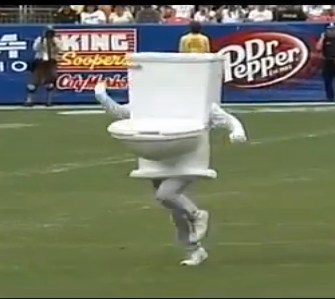Confessions of an Environmental Outreach Strategist
POSTED ON June 6th, 2013 BY adminAt Gigantic we have a favorite guerilla marketing example we like to show to our clients, and we refer to it often in our own campaign brainstorms as well: the running toilet video…
In the video, a toilet mascot running across the field at a football game gets tackled by a security guard, followed by the message “Denver Water asks you to stop running toilets.” It’s brilliant, it’s simple, it’s funny, it’s memorable. I’ve been touting it without hesitation and without any qualms about, um, the fact that I’ve had a running toilet at home for months.
Our leaky toilet shuts itself on and off as though it were haunted by some ghost with a bladder problem. It seemed like a relatively minor nuisance — until last Tuesday, when our water bill showed just how significant the leak really is. Comparing 2012 and 2013 over the same period, our water usage went up a whopping 50 percent!
 As I said, I can’t claim that my husband and I weren’t aware the toilet was running. There’ve been many nights when the sound actually woke us up. We even tried to fix it once, but our repair job was only partially effective. (The ghost’s bladder issues seem to have subsided a bit, but the poor dear’s symptoms occasionally return with a vengeance.) And there are barriers to getting a new toilet: We forget, we have other things scheduled, we’re afraid to find out what other repairs might be needed in the bathroom if we looked too closely at our aging commode. And then there’s choosing the new toilet: we’d have to compare the water usage ratings, check Consumer Reports’ recommendations, make sure it’s just the right one — even though, truth be told, anything would be better than what we’ve got.
As I said, I can’t claim that my husband and I weren’t aware the toilet was running. There’ve been many nights when the sound actually woke us up. We even tried to fix it once, but our repair job was only partially effective. (The ghost’s bladder issues seem to have subsided a bit, but the poor dear’s symptoms occasionally return with a vengeance.) And there are barriers to getting a new toilet: We forget, we have other things scheduled, we’re afraid to find out what other repairs might be needed in the bathroom if we looked too closely at our aging commode. And then there’s choosing the new toilet: we’d have to compare the water usage ratings, check Consumer Reports’ recommendations, make sure it’s just the right one — even though, truth be told, anything would be better than what we’ve got.
So I have lots of good reasons for not modeling the behavior I’ve been fervently, if indirectly, promoting. But there are some awfully good reasons why I need to be the first to change:
- Being credible. When I suggest that others “stop running toilets,” I’m implicitly saying this isn’t an issue that I have. No, I’m not lying, exactly. But I’m not being completely up-front, either. Modeling the behavior you wish to diffuse is key. Without this, you have no credibility. So what? No credibility means no buy-in from your target audience. Why should they do what you’re asking, if you’re not doing it yourself?
- Feeling the pain. You’ll understand how others perceive barriers and benefits if you go through all the steps of adopting the new behavior or innovation yourself. Then your next outreach campaign on the subject will be much more on-target and effective.
- Reaping the rewards. You yourself will save water, electricity, gas … whatever resource the new behavior or innovation addresses. Imagine that!
This is all a way of saying that behavior change outreach must begin at home. But I shouldn’t be telling you any of this yet, should I? I have a running toilet to tackle first.